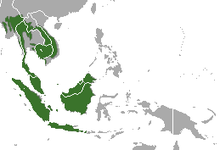Sunda pangolin
| Sunda pangolin | |
|---|---|

| |
| Scientific classification | |
| Domain: | Eukaryota |
| Kingdom: | Animalia |
| Phylum: | Chordata |
| Class: | Mammalia |
| Order: | Pholidota |
| Family: | Manidae |
| Genus: | Manis |
| Subgenus: | Paramanis
|
| Species: | M. javanica
|
| Binomial name | |
| Manis javanica Desmarest, 1822
| |

| |
| Sunda pangolin range | |
The Sunda pangolin (Manis javanica), also known as the Malayan or Javan pangolin, is a species of pangolin.[2]
It is found throughout Southeast Asia, including Myanmar, Thailand, Cambodia, Laos, Malaysia, Singapore, Vietnam, and the islands of Borneo, Java, Sumatra and the Lesser Sunda Islands.[1] It prefers forested habitats (primary, secondary, and scrub forest) and plantations (rubber, palm oil). A large part of its life is spent in trees.
Taxonomy
In the past, this species has included the closely related
Description
The skin of the Sunda pangolin's feet is granular, although pads are found on its front feet. It has thick and powerful claws to dig into the soils in search of ant nests or to tear into termite mounds. The Sunda pangolin has poor eyesight, but a highly developed sense of smell. Lacking teeth, its long, sticky tongue serves to collect ants and termites. Its body is covered by rows of scales and fibrous hair. The head-body length of this pangolin can measure 40–65 cm (16–26 in), tail length is 35–56 cm (14–22 in), and its weight is up to 10 kg (22 lb). Males are larger than females.[3][4]
Behaviour and ecology

Pangolins give birth annually to one or two offspring. They breed in the autumn, and females give birth in the winter burrow. Den preference has been known to shift at this time to favor mature forest tree hollows. Presumably, these hollows offer more fortification and stability for the decreased mobility that comes with birthing and caring for young. The amount of time the mother will spend at any one of these dens will increase during parental care periods.[5] Parental care is given for about three months. In these three months, the range of the mother Pangolin drastically decreases as she travels and forages with her offspring. Only a few weeks before the offspring becomes fully independent, the mother and her young can display brief spikes in diurnal activity.[5] Pangolins are sometimes found in pairs, but normally they are solitary, nocturnal, and behave timidly. They protect their soft underparts by rolling into balls when they feel threatened. They are strong diggers and make burrows lined with vegetation for insulation near termite mounds and ant nests.[1]
Sunda pangolins have low immunity, making them sensitive to fluctuations in temperature.[6]
The Sunda pangolin's main predators are humans, tigers, and the clouded leopard.[citation needed]
In culture
It is important to the traditions of Orang Asli in the Malay Peninsula and indigenous peoples of Sabah like the Kadazan, Dusun, Murut and Rungus. The Kadazans use its scales to make special armour to protect their warriors.[7]
Conservation

Pangolins as a family are among the most heavily poached and exploited protected animals. Like other pangolin species, the Sunda pangolin is hunted for its skin, scales, and meat, used in clothing manufacture and traditional medicine. Scales are made into rings as charms against rheumatic fever, and meat is eaten by indigenous peoples. Despite enjoying protected status almost everywhere in its range, illegal international trade, largely driven by Chinese buyers, has led to rapidly decreasing population numbers. The Sunda pangolin is currently considered to be
Health
A
Pangolin coronaviruses found to date only share at most 92% of their whole genomes with SARS-CoV-2, making them less similar than RaTG13 to SARS-CoV-2.[15] This is insufficient to prove pangolins to be the intermediate host; in comparison, the SARS virus responsible for the 2002–2004 outbreak shared 99.8% of its genome with a known civet coronavirus.[16]
References
- ^ . Retrieved 17 January 2022.
- OCLC 62265494.
- ^ OCLC 62265494.
- ISBN 978-1906780715.
- ^ doi:10.3354/esr00032.
- S2CID 202727934.
- ISBN 978-967-0237-73-2.
- ^ Carrington, D. (2016). "Pangolins thrown a lifeline at global wildlife summit with total trade ban". The Guardian.
- ^ "China raises protection for pangolins by removing scales from medicine list". The Guardian. 2020. Retrieved 22 June 2020.
- PMID 31652964.
- from the original on 7 February 2020. Retrieved 12 February 2020.
- PMID 32380510.
- ^ Kelly, G. (2015). "Pangolins: 13 facts about the world's most hunted animal". The Telegraph. Archived from the original on 24 December 2019. Retrieved 9 March 2020.
- ^ Gorman, J. (2020). "China's Ban on Wildlife trade a big step, but has loopholes, conservationists say". The New York Times. Archived from the original on 13 March 2020. Retrieved 23 March 2020.
- PMID 32197085.
- S2CID 256822283.
External links
- Sunda pangolin at Ecology Asia [1]
- Sunda pangolin at Animal Diversity Web
- WWF & TRAFFIC Report: Pangolin trade in Sabah (PDF)
- WWF News: Seized notebooks give unique insight into scale of illicit pangolin trade

